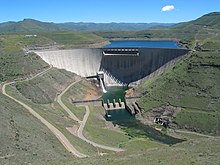Katse Dam


The Katse Dam, part of the Lesotho Highlands Water Project--Africa's largest dam project, eventually to include 5 large dams in remote rural areas--is a concrete arch dam in Lesotho. The potential of the project was identified by the South African Civil Engineer Ninham Shand as a possible means to supplement the water supply to South Africa. The World Bank arranged for a treaty between the then-Apartheid government of South Africa and its much smaller neighbor, Lesotho, allowing execution of the project to proceed.
The dam was completed in 1996 and filled by 1997, causing induced seismicity.[1] Farmers who lost land to the project have had trouble re-establishing new livelihoods. There is little arable land in Lesotho to replace all that was lost, and efforts to help them with new livelihoods have taken a back-seat to engineering works. (A local group has documented the project's human legacy in the rural communities directly affected by the project: http://www.trc.org.ls/water.htm)
Water from the dam first travels through a 45 km, 4 m diameter tunnel, exiting at a hydroelectric station near Muela. The dam's high elevation allows a gravity flow delivery system to South Africa, in addition to hydroelectric power for Lesotho, and was a prime reason behind the choice of site.
Water delivery officially began on 22 January 1998. The dam currently supplies about 30 m³/s of water to South Africa, which pays Lesotho $5 million per year, plus a variable royalty based on calculated water usage benefits.
Ironically, Lesotho has required food aid in recent times during a number of drought years, despite having large reservoirs in its midst. Highlands farmers are not allowed to use the waters of the reservoir.
The dam project has also been a source of widespread corruption (http://www.irn.org/programs/lesotho/index.php?id=corruption.html), which is not uncommon with large dam projects. The Lesotho courts have taken the unusual step of prosecuting the large companies involved in the scandal in addition to the Lesotho bureaucrat who took the bribes. Thus far, there have been a number of convictions and at least one company debarred by the World Bank for its role in the scandal.
Dam features
- Height - 185 m
- Crest length - 710 m
- Design - double arch, concrete
- Concrete - 2,320,000 cubic meters
- 1993 meters above sea level (highest Dam in Africa)[2]
External links
Lesotho Highlands Development Authority (http://www.lhwp.org.ls/)
International Rivers Network (http://www.irn.org/programs/lesotho/)
Transformation Resource Centre (http://www.trc.org.ls/)
